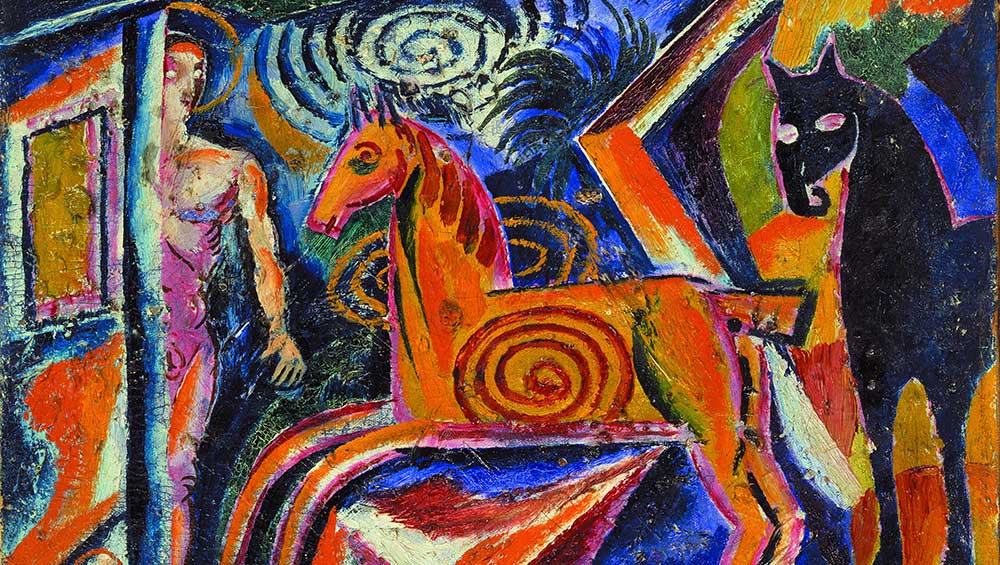
Davyd Burliuk, Carousel, 1921 (detail). Oil on canvas, 33 x 45.5 cm. National Art Museum of Ukraine. © The Burliuk Foundation.
Royal Academy of Arts, London
29 June – 13 October 2024
by JOE LLOYD
What’s in a name? For decades art historians have hailed Kazimir Malevich as one of the most pioneering Russian artists of the 20th century, renowned for his abstract paintings. Malevich lived and worked in Soviet Moscow and died in Leningrad. But he was born Kazimierz Malewicz to Polish parents in Kyiv, then in the Russian empire. He also loved the rural Ukrainian culture that surrounded him as a child. When he was arrested in 1930, he gave his nationality as Ukrainian. He wrote several articles in the language. In Kyiv, he was Kazymyr Malevych.
He now appears under this name at the Royal Academy, with a dream-like 1927 landscape and a 1930 sketch for a fresco to adorn the All-Ukrainian Academy of Sciences, which looks to adopt the Byzantine-style Christian painting favoured in Ukraine’s Greek Orthodox churches. Malevych is one of several big names that appear inIn the Eye of the Storm: Modernism in Ukraine, 1900-1930s, an exhibition of 65 works largely drawn from the national museums of Ukraine. There is an atypically moody, tentative El Lissitzky Composition (c1918-20s) and a radiant landscape called Simultaneous Contrasts (1913) by Odessa-born, St Petersburg-raised Sonia Delaunay. But the bulk of the exhibition serves to introduce audiences outside Ukraine to the lesser-known artists who practised within what is now Ukraine.
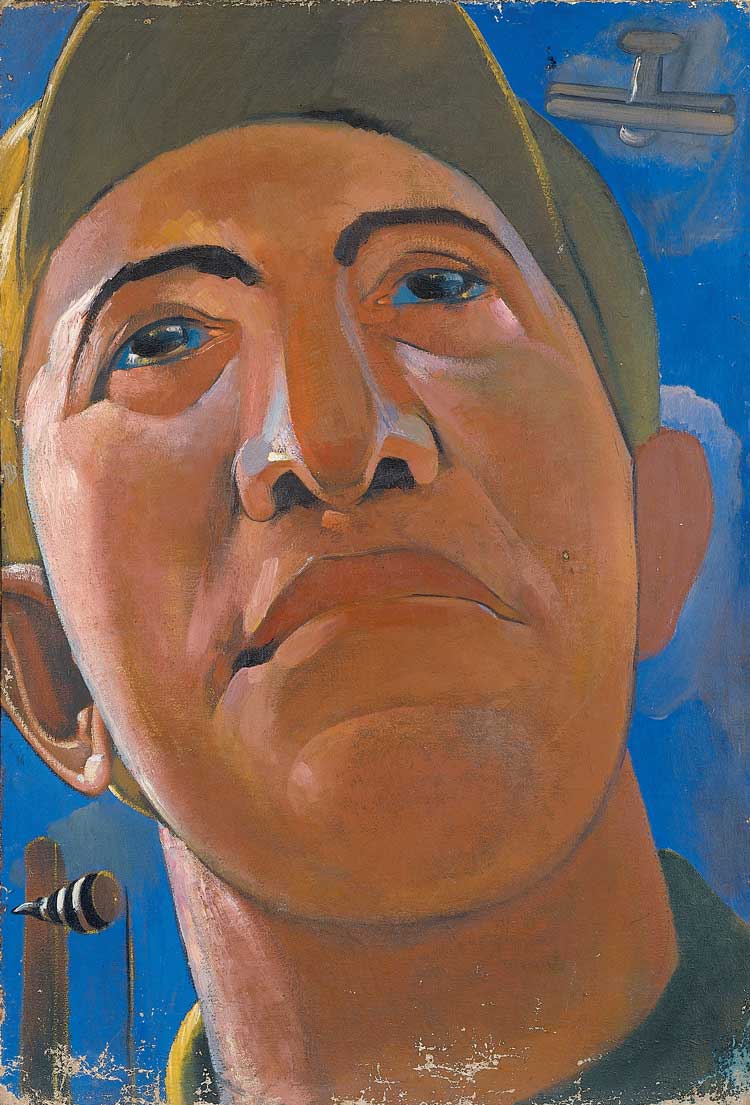
Kostiantyn Yeleva, Portrait, late 1920s. Oil on canvas, 145 x 100 cm. National Art Museum of Ukraine.
The region inhabited by Ukrainians has seldom been an unchallenged polity. During the years the exhibition covers alone, it went through a convoluted sequence of boundary changes. Empires collapsed and independent states emerged. The Soviet Union eventually hoovered up the lot. War, famine, persecution, a humongous enemy to the east: there are parallels that reverberate a century later. Anatol Petrytskyi’s The Invalids (1924) is a stark bench of the maimed and blinded, while Manuil Shekhtman’s Jewish Pogrom (1926) has starved, suffering figures huddled beneath a writhing pile of corpses. Between 1918 and 1921 an estimated 100,000 Jewish people in Ukraine were attacked and killed as the region seethed in war.
Western art history has often subsumed the art of Ukraine, as well as that of other states that eventually became part of the Soviet Union, under a Russian umbrella. The RA’s own 2017 survey of Soviet art was entitled Revolution: Russian Art 1917-1932. This exhibition asserts that the art made within Ukraine deserves to be considered separately. It is a soft front in the continuing war, ensuring that Ukrainian art is protected, promoted and better known. Darkly, it aims to forestall a repeat of the suppression of ethnic Ukrainian art in the 1930s, the period that saw Stalin’s regime brutally turn against the avant garde and prescribe saccharine socialist realism.
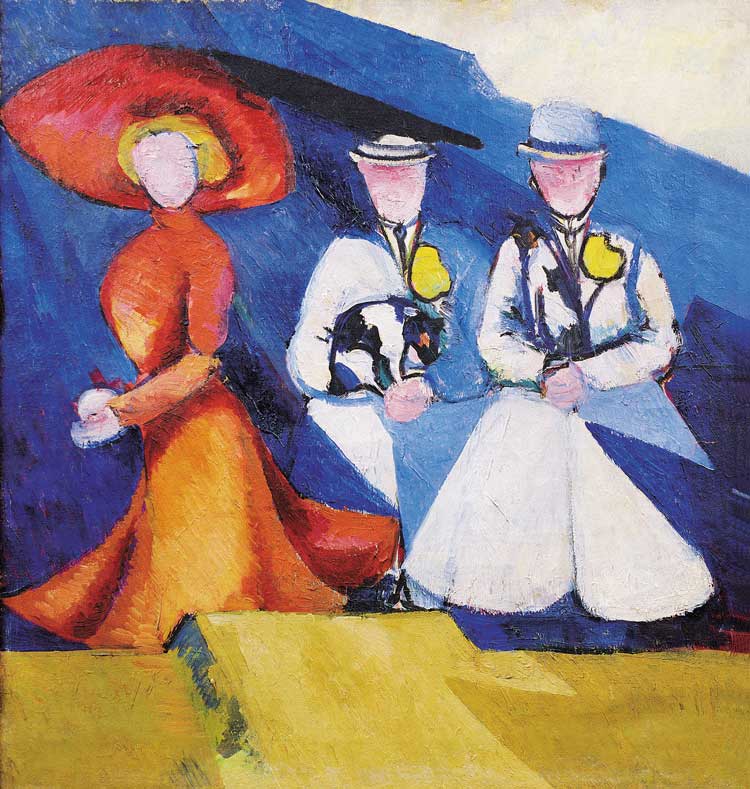
Alexandra Exter, Three Female Figures, 1909-10. Oil on canvas, 63 x 60 cm. National Art Museum of Ukraine.
We already know where this exhibition will end. It is especially fascinating to see where it begins. The first room at the RA presents a flood of artists who sought to fuse fragmented cubism with dynamic futurism. As in the latter movement, there are a lot of horses and cityscapes. Alexandra Exter – born in Poland to Belarussian and Greek parents, flitting between Kyiv and Moscow before emigrating to France – painted elegant ladies with blank, proto-Malevych faces (1909-10) and geometric architectural compositions (1912). In 1918, she opened a studio in Kyiv and became a mentor to a generation of painters and stage designers.
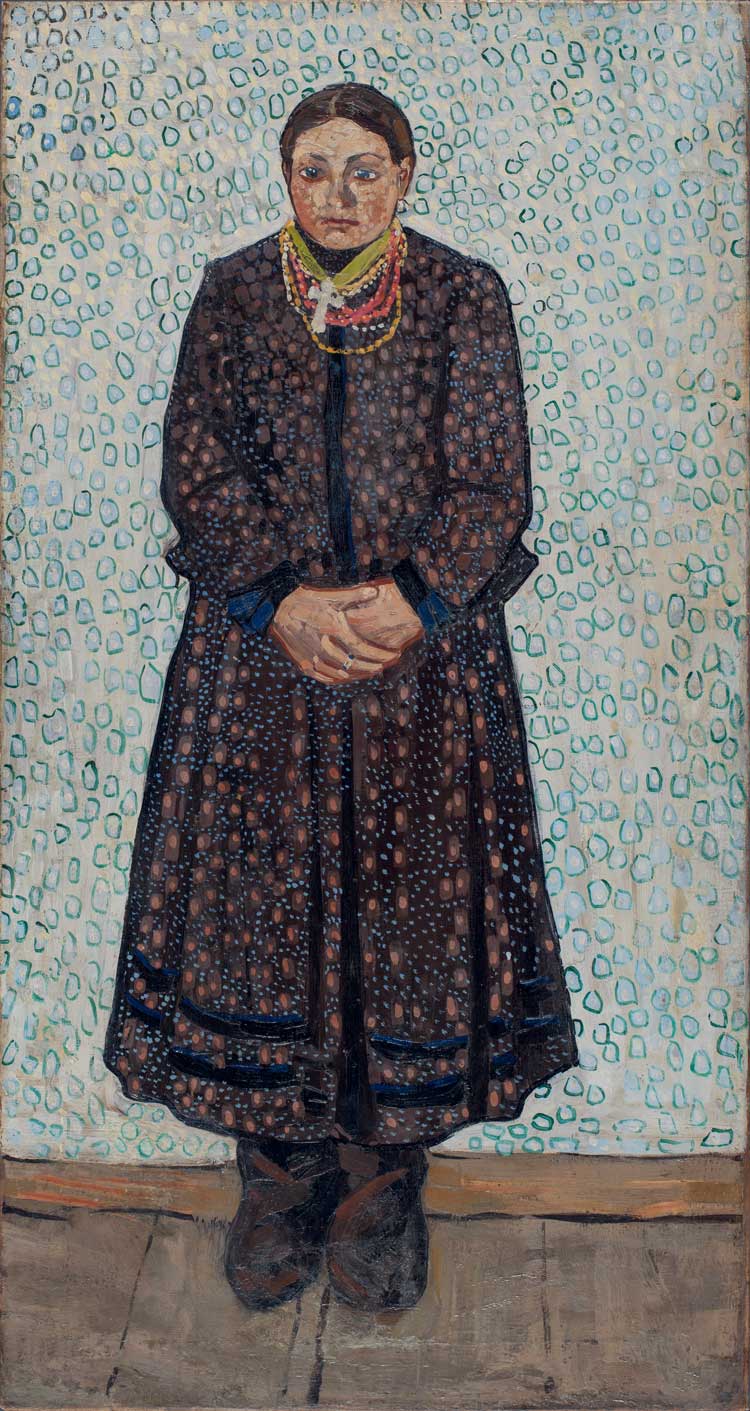
Volodymyr Burliuk, Ukrainian Peasant Woman, 1910–11. Oil on canvas, 132 x 70 cm. Museo Nacional Thyssen-Bornemisza, Madrid.
© Museo Nacional Thyssen-Bornemisza, Madrid.
A section on theatrical costume design shows a thriving experimental stage, albeit one that fused cubo-futurist costumes with those harking back to ecclesiastical icons. The fusion of modernist aesthetics from the west and local tradition is a common one here. The exhibition begins with Volodymyr Burliuk’s Van Gogh-esque portrait of a Ukrainian Peasant Woman (1910-11), rugged and solid, a figure that could have existed for centuries. Mykhalio Boichuk, a leading figure in the 1920s, pioneered a style that combined aspects of European modernism with Byzantine art, medieval frescoes and Ukrainian folk tradition. His Dairy Maid (1922-23) has the beatific grace of an Italian gothic saint. Boichuk inspired an entire school of artists. Vasyl Sedliar’s Portrait of Oksana Pavlenko, a fellow painter, places a neo-Byzantine figure before an Orphic background.
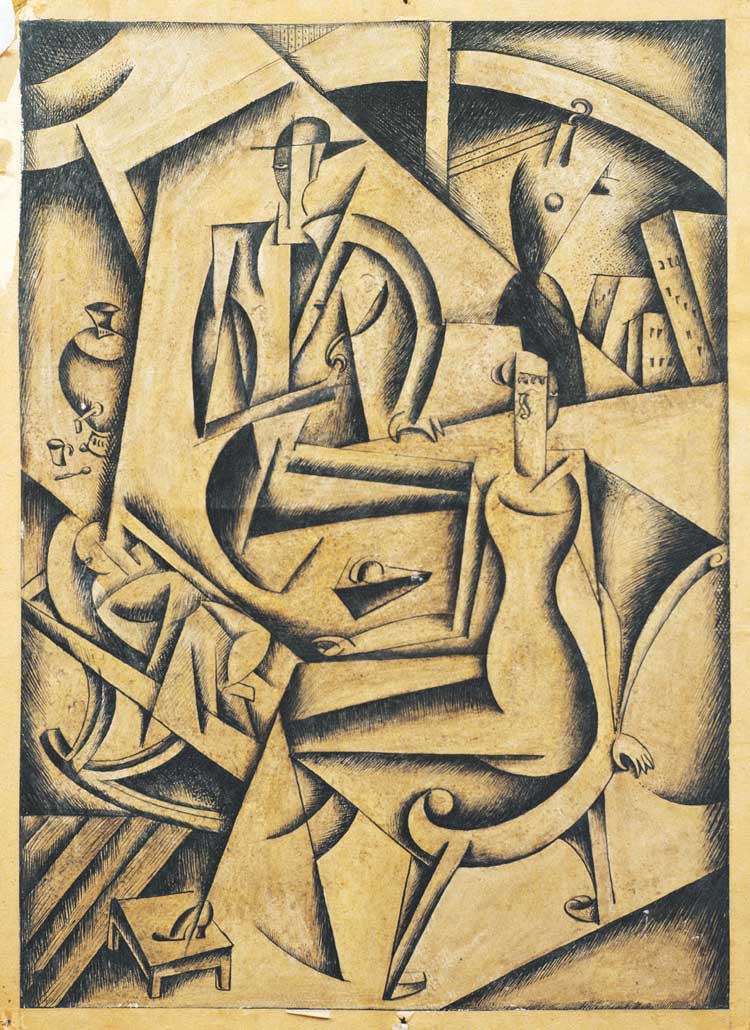
Marko Epshtein, The Tailor’s Family, c1920. Indian ink and watercolour on paper pasted on cardboard, 46.5 x 32.5 cm. National Art Museum of Ukraine.
This mode did not last long. Stalin’s regime favoured the suppression of individual national identities within the Union. Boichuk and Sedliar would be executed during the Great Purge of 1937, accused of being members of a nationalist terrorist group. Many of their works were destroyed. The final section of the exhibition heralds the demise of the avant garde. A symbolic moment was the death of Oleksandr Bohomazov from tuberculosis in 1930. His unfinished final work was to be a triptych depicting sawyers.
One of the two finished panels, Sharpening the Saws (1927), sets the Royal Academy ablaze with its brilliance. It depicts three workers, sweat-drenched but satisfied, oddly suave in their loose trousers and open-necked shirts. Two of them sit on a heap of logs and beams that retain some of the old cubist geometries. The saws themselves are spiky belts of colour which surge towards the front of the canvas. Bohomazov had found a language that allowed for experimentation to coexist with the depiction of life.
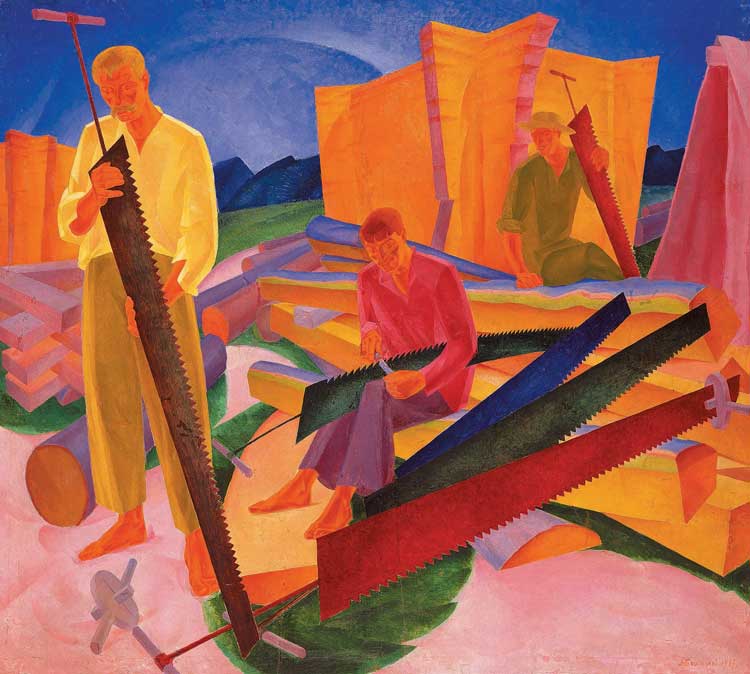
Oleksandr Bohomazov, Sharpening the Saws, 1927. Oil on canvas, 138 x 155 cm. National Art Museum of Ukraine.
The last room contains three large-scale works that show the dying embers of experimentation. A late 1920s portrait by Kostiantyn Yeleva depicts a man, perhaps marked out as an air force member or engineer by the plane in his background, staring ahead with weary, almost teary-eyed resolution. His face occupies nearly the entirety of the canvas, like a cinematic closeup (or a smartphone selfie almost a century ahead of time). Oleksandr Syrotenko’s Rest (1927) features four farm labourers stopping to enjoy a meagre picnic of bread, onions and pickles, against a colour field sky. Perhaps the strangest of all is Semen Yoffe’s In the Shooting Gallery (1932). One statuesque woman holds up a paper target while another, solemn, clomping with heavy steps, strides towards her. In the background is an eerie, almost De Chirico-esque landscape with a pearlescent sky, realism with a shot of the surreal.
Few of the works here will crash into the modernist canon. But many of them have merit. And they serve as important artefacts in the broadening out of art history, away from the handful of metropolitan scenes and Provencal beauty spots that have come to dominate our view of early 20th-century art. The amalgamation of modernist ideals, drawn from first-hand travels and periodicals, with a pre-existing regional culture lends many a particular interest. Given the situation today, visiting the RA and learning about Ukrainian art seems a small tribute to this vast, vibrant and various country.